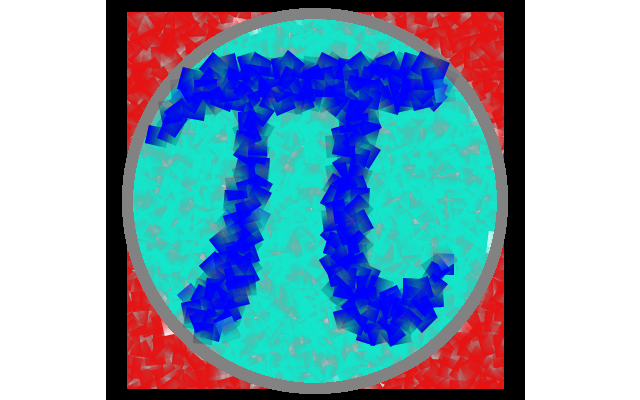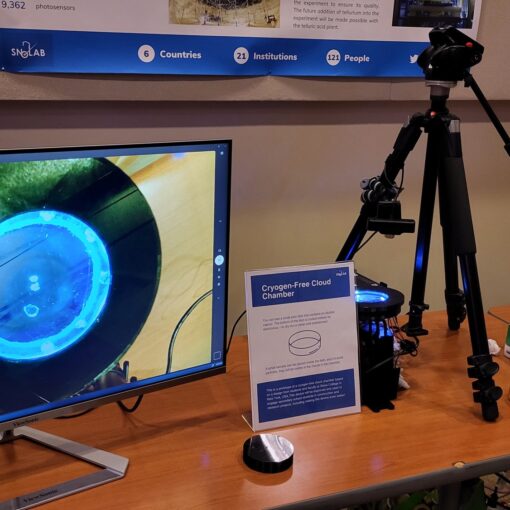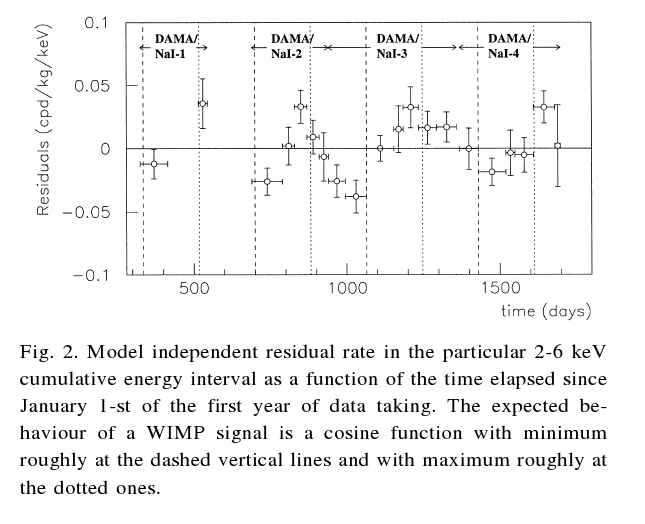
This summer began, for me, with a little bit of travel. The first part was for relaxation; Jodi, her oldest younger sister, and I went to Paris for a week. After that, we headed to the conference “Rencontres de Blois” for which Jodi is an organizer. In these brief “field notes,” I report on things I learned at the conference.
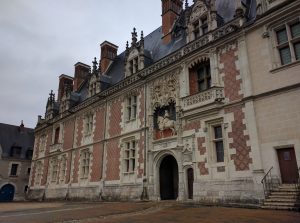
Rencontres du Blois is a yearly conference in the city of Blois, located in the Loire Valley southwest of Paris. It brings together physicists and astronomers at the interface of particle and high-energy physics, astrophysics, astronomy, and cosmology. My personal interest in this is merely that I believe the most interesting problems we face in understanding the universe lie at the intersection of these fields, and will be solved by coming at those problems from all of these directions. Some of these problems are: the nature of dark matter; the nature of dark energy; gravitational waves and their behavior and information content, both in the present and early universe; the nature of neutrinos; the nature of the Higgs boson; the nature of physical laws that include, but supercede, the Standard Model of Particle Physics.
I took several key messages away from this year’s conference. This is my own biased list, skewed toward my own interests and to things I think can alter the course of our understanding in the next year, decade, and century.
- The era of gravitational wave astronomy is upon us.
- The community is champing at the bit to know what is going on (if anything) at 750 GeV in the two-photon mass spectrum measured by the ATLAS and CMS Experiments.
- The hunt for dark matter is continuing to leap forward as new generations of direction detection experiments are built and/or come online.
- The hunt for B-mode polarization in the cosmic microwave background goes on, with a diverse spectrum of competing experiments.
I’ll comment on these things below.
The era of gravitational wave astronomy is upon us
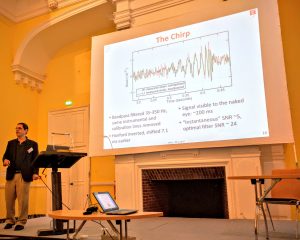
Bruce Allen, director of the Max Planck Institute for Gravitational Physics, presented the LIGO Scientific Collaboration’s result from earlier this year showing definitive evidence of the merger of two, approximately 30-solar-mass black holes. Given the short time to make his presentation, Bruce presented the topic masterfully and left time for questions from the audience at the end. Of course, we were all excited to know when more scientific results would appear from the collaboration, since more data has been taken since the initial data set that contained this spectacular signal. Bruce had to play his cards close to his vest, but he assured us that the LIGO Scientific Collaboration has been hard at work analyzing the additional data and that they would have more to say in the near future.
We also learned a little about the LISA Pathfinder Mission [1], a European Space Agency scientific mission to assess the technology behind a future planned gravitational wave observatory located not on Earth, but in space, called LISA. Bruce also hinted that ESA would soon announce first results from the LISA Pathfinder Mission; indeed, just last week there was a press conference where we learned that the mission has exceeded its goals. The technology works better, overall, than it was expected to perform during this exploratory mission.
Hungry for the two-photon mass spectrum
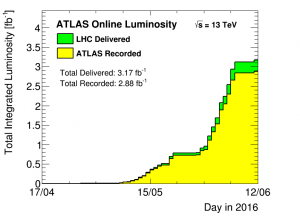
The Large Hadron Collider has been taking a new round of data this year to complement the 2015 data set, which led to an accumulation of 3.2/fb (this is equivalent to the collider producing 16,000 Higgs bosons – of course, we have to sift those out of all the vast piles of noise the collider also makes, so you don’t get the benefit of every single one of those Higgs bosons when you do your studies of this particle). So far, this year, the ATLAS Experiment (on which I work) has accumulated an additional 2.88/fb for physics analysis. More data will come as we move through the summer, but efforts to analyze this first new batch is already underway. While I don’t work on one of the hottest topics on the LHC right now, we’re all feeling the pressure to do more with every drop of data we get this year.
The hottest topic, hands down, has to be the “bump” in the mass spectrum of photon pairs, “seen” by both the ATLAS and CMS Experiments in December and still “seen” in March (using mostly the same data from 2015). I put things in air quotes because these are just NOT statistically significant signals yet. It’s intriguing that two experiments operating independently see something at the same mass-energy location, but that doesn’t make it real. In my own field, the standard is that we don’t get excited until the probability that background could be faking this reaches a chance of 1-in-1,744,277 .89362, assuming Gaussian probability distributions; this is also known as the “5 sigma” standard for discovery. Neither experiment has even achieved 3 sigma yet, the threshold for “having a good feeling about this.” Nonetheless, the community is extremely excited about the possibility that new data could make this signal stronger, if it’s real, and we’re all awaiting word from the ATLAS and CMS Experiments later this summer and later this year.
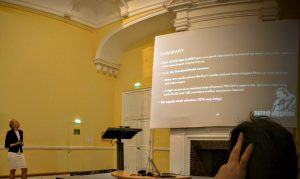
A lot of conversation was spent on this subject at the conference. Presentations that covered it led to lively questions afterward and more discussion over lunch and dinner. It’s a pretty hot topic; whether it all turns out to be hot air will be decided soon, when we nearly double the data set from 2015 and start showing results publicly on this and many other subjects of interest to the community. I don’t work directly on this subject myself, and ATLAS is a HUGE collaboration (about 3000 physicists), so even I am eagerly waiting to see how the progress and internal review of such searches proceeds over the next weeks and months. Certainly, having been at CERN before the big Higgs announcements in 2012 I can say that the mood is approaching the same level – cautious, careful, nervous, optimistic, fearful that nature delivered a statistical fluctuation or, worse, a discovery. I joke about that last bit, but we all know that statistical fluctuations go away and are soon forgotten, but discoveries change the direction of a field for decades to come. I am just as excited as anybody else to know which it will be.
The Hunt for Dark Matter
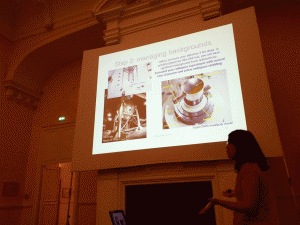
It’s been a long time since dark matter was hypothesized, and it’s been about 2 decades since the physics community became definitively convinced by the many lines of evidence that something exotic is floating around out their in space, shaping the structure of the cosmos. What it is, we still do not know, but its nature is one of the deep mysteries of our time. For those invested in the particle hypothesis for dark matter, the hunt is entering a new phase of sensitivity that will push many experiments to such incredible levels of ability that they may begin to detect some of the lowest energy neutrinos emitted by the Sun’s own natural energy-production processes; such rare, elusive, ghostly particles have only barely been seen by dedicated experiments, and a whole suite of new experiments tuned to hunt for dark matter are about to push their own sensitivity so hard that they will begin to see these known but elusive particles in their own experiments. It’s incredible. As always, the community waits for news as to whether or not dark matter is a particle that even can interact with things we already know about, like protons, neutrons, or electrons.
Gravity and Light – the echoes of the Big Bang
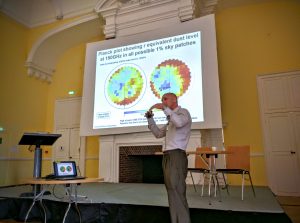
One area where I continue to watch with great interest is the search for the imprint of gravitational waves from the very, very early universe on the light left over from that time, the “cosmic microwave background” or “CMB”. At Blois, excellent overviews of some of the scientific programs designed to try to measure these elusive fingerprints were given by scientists like Clem Pryke (University of Minnesota) and Jeff Filippini (University of Illinois Urbana-Champaign). I think this is one of the most exciting areas of our field right now, a combination of extremely precise and intricate engineering of novel instrumentation, combined with light left over from the beginning of time and the ways in which mass-energy imprints itself through polarization on that light. It’s an incredible area of our field, one that continues to push the boundaries and remain exciting. I have a soft spot for this subject, and I am excited to see new data analysis results from experiments that are promising impressive leaps in sensitivity, like KECK and SPIDER.

